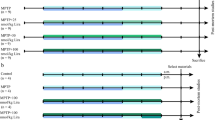Abstract
Alzheimer’s disease (AD) is characterized by neuronal necroptosis and neuroinflammation, retardation of these pathological development was considered to play crucial role in the treatment of AD. RIPK1, a receptor-interacting serine/threonine-protein kinase 1, was reported to be involved in the mediation of neuronal necroptosis and neuroinflammation. Previous investigations indicated that the agonists of glucagon like peptide-1 receptor (GLP-1R) such as Liraglutide, showed ameliorating effect against the development of Alzheimer’s disease on model mice, however, the mechanisms by which GLP-1R agonists function in AD remains elusive. The effect of Liraglutide on the retardation of the AD progression upon regulation of RIPK1 was studied using biochemical and immune-histochemical assays in model mice. Results in this study ascertained that the GLP-1R agonists possessed inhibitory effect on RIPK1-mediated necroptosis and microglial activation in vitro and in vivo. It was evidenced that the utility of GLP-1R agonist is capable to reduce RIPK1 activity significantly and the effect of GLP-1R agonist showed PKA depended manner. This study clarified the relationship of GLP-1R agonist and RIPK1 and demonstrating the physiological effect of GLP-1R agonist in amelioration of AD. This study provided a mechanism underlying the function of GLP-1R agonist in AD and suggested a potential therapeutic strategies for the treatment of AD.




Similar content being viewed by others
Data Availability
The datasets used and / or analyzed during the current study are available from the corresponding author on reasonable request.
Change history
26 May 2022
A Correction to this paper has been published: https://doi.org/10.1007/s10989-022-10422-0
Abbreviations
- AD:
-
Alzheimer’s disease
- RIPK1:
-
Receptor-interacting serine/threonine-protein kinase 1
- GLP-1R:
-
Glucagon-like peptide-1 receptor
References
Batista AF et al (2018) The diabetes drug liraglutide reverses cognitive impairment in mice and attenuates insulin receptor and synaptic pathology in a non-human primate model of Alzheimer’s disease. J Pathol 245(1):85–100
Caccamo A et al (2017) Necroptosis activation in Alzheimer’s disease. Nat Neurosci 20(9):1236–1246
Cameron B, Landreth GE (2010) Inflammation, microglia, and Alzheimer’s disease. Neurobiol Dis 37(3):503–509
Chen WW et al (2016) Role of neuroinflammation in neurodegenerative diseases (Review). Mol Med Rep 13(4):3391–3396
Cho Y et al (2011) RIP1-dependent and independent effects of necrostatin-1 in necrosis and T cell activation. PLoS ONE 6(8):e23209
Degterev A et al (2005) Chemical inhibitor of nonapoptotic cell death with therapeutic potential for ischemic brain injury. Nat Chem Biol 1(2):112–119
Duarte AI et al (2020) Liraglutide protects against brain amyloid-beta1–42 accumulation in female mice with early alzheimer’s disease-like pathology by partially rescuing oxidative/nitrosative stress and inflammation. Int J Mol Sci 21(5):1746
During MJ et al (2003) Glucagon-like peptide-1 receptor is involved in learning and neuroprotection. Nat Med 9(9):1173–1179
Geng J et al (2017) Regulation of RIPK1 activation by TAK1-mediated phosphorylation dictates apoptosis and necroptosis. Nat Commun 8(1):359
Holscher C (2014) Central effects of GLP-1: new opportunities for treatments of neurodegenerative diseases. J Endocrinol 221(1):T31-41
Hong H et al (2016) Pathophysiological role of neuroinflammation in neurodegenerative diseases and psychiatric disorders. Int Neurourol J 20(Suppl 1):S2-7
Ito Y et al (2016) RIPK1 mediates axonal degeneration by promoting inflammation and necroptosis in ALS. Science 353(6299):603–608
Jiao JJ et al (2017) GLP-1/GIP/Gcg receptor Triagonist improves the cognitive behaviors in triple-transgenic mice of Alzheimer’s disease. Sheng Li Xue Bao 69(2):135–145
Lee CH et al (2017) Activation of glucagon-like peptide-1 receptor promotes neuroprotection in experimental autoimmune encephalomyelitis by reducing neuroinflammatory responses. Mol Neurobiol 55(4):3007–3020
Li Y et al (2014) Microglia in Alzheimer’s disease. Biomed Res Int 2014:437483
Li H et al (2018) GLP-1 receptor regulates cell growth through regulating IDE expression level in Abeta1–42-treated PC12 cells. Biosci Rep 38(4):392–404
Linkermann A, Green DR (2014) Necroptosis. N Engl J Med 370(5):455–465
Mandrekar-Colucci S, Landreth GE (2010) Microglia and inflammation in Alzheimer’s disease. CNS Neurol Disord Drug Targets 9(2):156–167
McClean PL et al (2015) Prophylactic liraglutide treatment prevents amyloid plaque deposition, chronic inflammation and memory impairment in APP/PS1 mice. Behav Brain Res 293:96–106
Meloni AR et al (2013) GLP-1 receptor activated insulin secretion from pancreatic beta-cells: mechanism and glucose dependence. Diabetes Obes Metab 15(1):15–27
Newton K et al (2016) RIPK1 inhibits ZBP1-driven necroptosis during development. Nature 540(7631):129–133
Ofengeim D et al (2015) Activation of necroptosis in multiple sclerosis. Cell Rep 10(11):1836–1849
Ofengeim D et al (2017) RIPK1 mediates a disease-associated microglial response in Alzheimer’s disease. Proc Natl Acad Sci U S A 114(41):E8788–E8797
Querfurth HW, LaFerla FM (2010) Alzheimer’s disease. N Engl J Med 362(4):329–344
Selkoe DJ (2001) Alzheimer’s disease: genes, proteins, and therapy.". Physiol Rev 81(2):741–766
Silke J et al (2015) The diverse role of RIP kinases in necroptosis and inflammation. Nat Immunol 16(7):689–697
Skaper SD et al (2014) Neuroinflammation, microglia and mast cells in the pathophysiology of neurocognitive disorders: a review. CNS Neurol Disord Drug Targets 13(10):1654–1666
Trujillo JM, Nuffer W (2014) GLP-1 receptor agonists for type 2 diabetes mellitus: recent developments and emerging agents. Pharmacotherapy 34(11):1174–1186
Funding
This study was supported by the National Natural Science Funding (81771221, 81870967, 81974521, 81974521 and 82071384). This study was also supported by the Tianjin health and Health Committee Foundation (ZC20184).
Author information
Authors and Affiliations
Corresponding authors
Ethics declarations
Conflict of interest
The authors declare that they have no Conflict of interest.
Ethical approval
All animal experiments were approved by the General Hospital of Tianjin Medical University and performed following the Guide for the Care and Use of Laboratory Animals and Stroke Treatment.
Additional information
Publisher's Note
Springer Nature remains neutral with regard to jurisdictional claims in published maps and institutional affiliations.
The original online version of this article was revised: the affiliation of Xiaodong Kong has been corrected.
Rights and permissions
About this article
Cite this article
Kong, X., Yang, Y., Li, H. et al. GLP-1 Receptor Agonist Inhibited the Activation of RIPK1 for Alleviation the Neuronal Death and Neuroinflammation in APP/PS1 Mice. Int J Pept Res Ther 27, 1699–1707 (2021). https://doi.org/10.1007/s10989-021-10202-2
Accepted:
Published:
Issue Date:
DOI: https://doi.org/10.1007/s10989-021-10202-2




